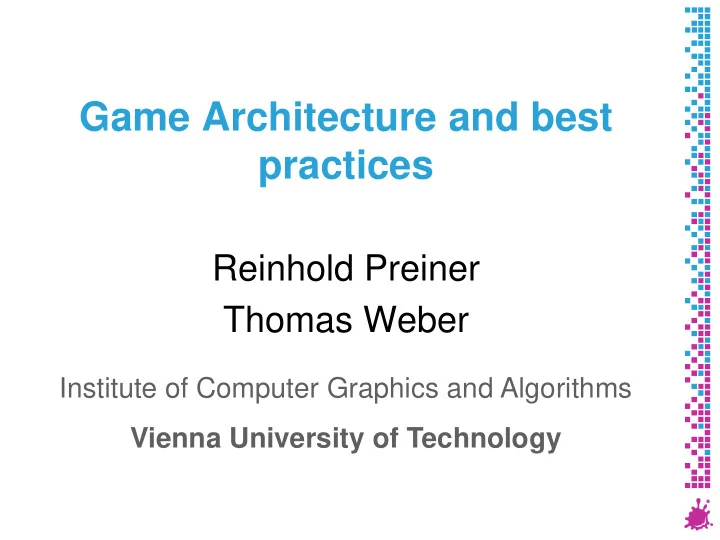

Game Architecture and best practices Reinhold Preiner Thomas Weber Institute of Computer Graphics and Algorithms Vienna University of Technology
Topics for today Software Architecture for Game Development Rules of software engineering Entity Management Scene-Representation Basic Game-Lifecycle The Render-Loop Resource Management Best Practices and Useful Tips Institute of Computer Graphics and Algorithms 1
Software Architecture for Game Development TOPICS FOR TODAY Institute of Computer Graphics and Algorithms 2
Some Rules of Good SW-Engineering SCALABILITY Be able to extend your System with minimal effort MAINTAINABILITY Be able to change/adapt your System with minimal effort MODULARITY If you have to do the procedure in different corners of your System, do it once in one module (class) and call it wherever you need it. These Concepts interact with each other But: Beware of Overengineering -> you only have one Semester! Reinhold Preiner & Thomas Weber 3
Entity management SceneObject {abstract} + update( double timediff ) + draw() Character Vehicle Tree Character::update() handles user input Vehicle::update() controlled by AI Tree::update() does nothing Institute of Computer Graphics and Algorithms 4
Scene-Representation Which data-structure for object organization? Depends on your needs 2 Basic approaches: Linear List (e.g. std::list<SceneObject*>) Advantage: Easy to implement Disadvantage: Bad for hierarchical scenes Scene-Graphs: Ideal for hierarchical animations (e.g. solar system) You can also use both (or none ;) ) Reinhold Preiner & Thomas Weber 5
Basic Game Lifecycle Load Content Render-Loop Update Content User Input Draw Content Display Output Cleanup Content Reinhold Preiner & Thomas Weber 6
Resource-Management Load Content Render-Loop Update Content User Input Draw Content Display Output Cleanup Content Reinhold Preiner & Thomas Weber 7
Resource-Management Common Design-Concepts: RAII Resource managing module Reinhold Preiner & Thomas Weber 8
RAII “Resource Acquisition Is Initialization” Constructor: Resource acquisition Textures, shader, meshes etc. Destructor: Release resources Advantages: Simplifies programming work Exception safe Disadvantage: Beware of shallow copies (see C++ talk / part 2) Reinhold Preiner & Thomas Weber 9
Resource-Managing-Module Central resource manager class handles all resources Has methods like: loadMesh, loadTexture, etc. Loads resources once and returns references Internally stores resources in maps Could also support reference counting Handles cleanup at application end Reinhold Preiner & Thomas Weber 10
Resource-Managing-Module Resource* loadResource( "resourceName" ) { if ( "resourceName" already loaded ) return lookup( "resourceName" ); else { res = loadFromFile( "resourceName" ); storeInMap( "resourceName", res ); return res; } } Reinhold Preiner & Thomas Weber 11
Render-Loop Load Content Render-Loop Update Content User Input Draw Content Display Output Cleanup Content Reinhold Preiner & Thomas Weber 12
Render-Loop while ( <running> ) { double dt = <Calculate time Delta to prev. Frame>; foreach SceneObject* so in sceneObjectList so- >update( dt ); foreach SceneObject* so in sceneObjectList so- >draw (); SceneObject {abstract} <Swap Buffers> + update( double timediff ) } + draw() Character Vehicle Tree Reinhold Preiner & Thomas Weber 13
Best Practices and Useful Tips TOPICS FOR TODAY Institute of Computer Graphics and Algorithms 14
OpenGL C++ Wrappers Wrapper objects for OpenGL functions For things like textures or shaders Example usage Shader shader (“ my_shader ”); Mesh mesh (“ teapot.mesh ”); shader.bind(); shader.setUniform (“color”, vec3(1,0,0)); mesh.draw(&shader); shader.unbind(); Write code before implementing wrappers Reinhold Preiner & Thomas Weber 15
Config-Loading Don’t hardcode constant values Use a config file Example syntax: lightColor 1 0.5 0.5 lightPosition 10 10 30 shaderName ‚ shader/myShader ‛ Tweak values without recompilation Example Config class: Config config (‚ game.config ‛); String shaderName = config.shaderName; Reinhold Preiner & Thomas Weber 16
Time Measurement Most frameworks support timer functions Clamp longer time differences Useful for debugging, pause state, etc. double last = 0.0, logicTime = 0.0; while (running) { double now = glfwGetTime(); double dT = min(config.maxDT, now-last); last = now; logicTime = logicTime + dT; } Reinhold Preiner & Thomas Weber 17
FPS computation Each frame do ++frames; if (now – last > config.framerateUpdateTime) { msPerFrame = 1000.0 * (now-last) / frames; last = now; frames = 0; } Encapsulate in function or class FPS = 1000 / msPerFrame ms/frame is preferable metric FPS just better known Reinhold Preiner & Thomas Weber 18
Input handling Polling for time spanning actions Pressing forward key Firing machine gun glfwGetKey(‘W’); Events for single key hits ESC, F-keys, etc. Firing grenade Execute action void GLFWCALL keyCallback(int key, int state) {…} glfwSetKeyCallback(keyCallback); Reinhold Preiner & Thomas Weber 20
Recommend
More recommend